
Everglades foods are unique experience
SHARK VALLEY, Fla.— The most important treasures of the Florida Everglades are often overlooked with all the fuss about the birds, snakes, bugs, fish and alligators.
These culinary treasures are far away from the fabulous Miami restaurants owned by celebrities, with high prices, small portions, extravagant live entertainment and crowds that are so hip they eat foie gras for breakfast.
Heading west on U.S. Hwy. 41, the Tamiami Trail and Calle Ocho, away from the café con leches and the arepas, old-time Florida shows itself through the smog.
There are no buildings, no tourists on rollerblades, no muscle queens strutting their stuff in Speedos.
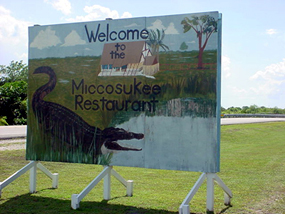 |
The Miccosukee Restaurant sign welcomes visitors (Photo by Liza Hearon). |
At Krome Avenue, the road becomes two lanes and only miles of swamp and vegetation are visible.
A deer peeks out of a bush from the side and quickly scurries back into its hiding place. The land returns to the time when Seminole and Miccosukee Indians roamed the swamps and only a few settlers tries to tame the land.
Soon the billboards appear: air boat rides, Indian villages, wildlife exhibits— and yes— restaurants.
The Miccosukee Indian Village is 25 miles west of Miami. It’s right across the highway from the entrance to Shark Valley, on the northern border of Everglades National Park. Shark Valley is a popular spot for visitors, featuring a tram ride, observational tower and trails to walk or bike.
The Miccosukee Restaurant is in a good spot to pick up those Shark Valley tourists plus the people coming for their airboat rides, tours of Indian Village or a visit to gift shop. It’s large inside, with vinyl booths similar to a truck stop gone local.
I almost expected a waitress named Cookie with long nails and too much lipstick to call me sweetie and take my order. Diners can also eat outside on a deck that provides a really nice view of the Everglades, provided they’re not worried about alligators or mosquitos snatching the baby.
The place was pretty full with the usual tourist crowd for a late Friday lunch.
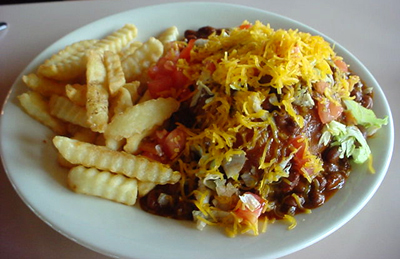 |
The Indian taco at the Miccosukee Restaurant (Photo by Liza Hearon). |
The front of the large, extensive menu said that along with their traditions, the Miccosukees like “jeans and t-shirts, and hamburgers and Coke.” That American standard mentality seems to dominate the menu, with the selections being mostly the type that Bob the Builder’s wife would put in his lunch pail for a day at the job— burgers, fries, chicken sandwiches.
However, one section offered more native fare: frog legs, catfish dinners, fry bread and hybrid food, like Indian burgers and tacos. Being the adventurous sort, I ordered fry bread with fruit and hush puppies and my companion ordered an Indian taco.
My fry bread came back fresh and hot. Indian fry bread is thick—almost a pastry but without the flakiness. The inside is soft and porous which lends itself nicely to a variety of fillings. Mine was filled with cherries that tasted like they had been sitting in a can in a shack in the swamp for 10 years and almost killed the delicious taste of the bread– but not quite.
The Indian taco was a monstrosity of a meal, with chili beans, cheese, tomato and other assorted taco ingredients in a pile on top of a wad of fry bread. The concoction was served with crinkle cut fries right out of the Ore-Ida bag in the frozen food aisle. Again, the fry bread was the main star of the meal, worth eating on its own rather than covered in piles of taco filling.
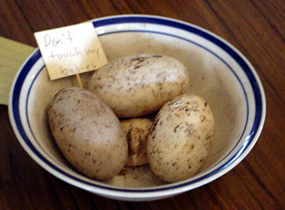 |
Gator eggs on display (Photo by Liza Hearon). |
The hush puppies, ordered as an appetizer, arrived right after we finished with the fry bread. The three of them were like big meatballs and still steaming hot from the kitchen. They were worth the wait, I suppose, with the taste of the cornmeal nicely balanced with just the right amount of spice.
The wait staff seemed anxious to move us out of there, but we had one more question.
“What’s sofkee?” I asked, as I saw a sign advertising it for a dollar.
“It’s an Indian soft drink, it’s made with rice,” the server said.
We decided to try some and what was delivered definitely didn’t match our expectations. The beverage was warm and had the consistency of a broth. It looked like soapy dishwater and didn’t smell like anything. It tasted faintly of rice and not much else. It was difficult to tell where the “soft drink” part came from.
After that dining experience, we headed back east to discover the other dining options in the region. About five miles east we stopped at the Safari Restaurant, which is a glorified snack bar for an airboat place. It was set up cafeteria style with drinks, snacks, prepackaged sandwiches and then choice of platters with hamburgers, frog legs, or catfish. Nothing too exciting.
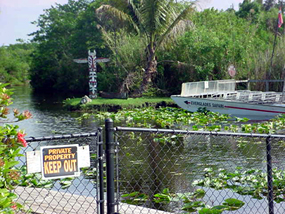 |
Airboats are common at Everglades tourist stops (Photo by Liza Hearon). |
Another five miles or so back east brought us to Gator Park, home of a giant airboat with a bear and a deer on it.
They have a bird garden out in the back with peacocks. A scarecrow outfit with an alligator head sits on the front porch, and a sign shows a picture of Gator Sausage, their claim to fame.
“It’s a third pound of sausage, served on a bun with coleslaw. It’s pretty popular, we sell about six or seven a day,” Dave the tour guide said.
Food at Gator Park is set up more for take out rather than an Everglades dining experience. Gator tail, frog legs and catfish can be bought by the pound and carried out. The smiling guides were more than happy to take our order, but the thought of all that gator sausage turned me off.
The final stop on the dining tour was the most impressive. Coopertown, 14 miles west of Miami with its population of exactly 0008 people, has a restaurant, along with airboat rides.
It’s a tiny white wooden building with a sign that says, “Illegally parked frogs will get toad away.”
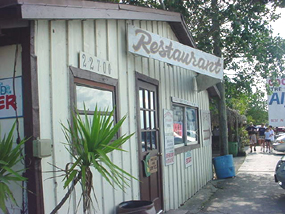
|
Above, Coopertown Restaurant. Below, the frogs are warned … (Photos by Liza Hearon). |
Coopertown really plays up its population eight charms with plenty of folklore for tourists. The menu describes how the restaurant gets its frog legs. The hunter leaves in an airboat in the middle of the night, with a bag to capture his prey. He returns around three in the morning with the frogs, ready for preparation at the restaurant.
The inside has a very homely feel, seating only about 20 people. A long counter on one side peddles Florida postcards, magnets and other souvenir trinkets. Business cards from the restaurant’s many visitors are stuck in the ceiling tiles. We spotted cards from all over the world, even Japan. The restaurant has a guest book and photos on the wall of famous people who have visited Coopertown.
The menu is the most old-world Florida out of any of the places we visited. Breakfast is hearty, with eggs, bacon and grits. Dinner plates are massive, with varying combinations of frog legs and gator tail. The restaurant also has catfish, shrimp, chicken and steak dinners.
The dinners include salad, French fries and garlic bread. Half a pound of gator tail with all the fixings costs $19.95, but when compared to dining in most Miami restaurants, Coopertown is a bargain. The menu also features standard fare, like hamburgers, hot dogs and BLTs.
After a long day of eating and snacking we left Florida of yesterday and headed back in to the busy Florida of today. It’s awfully difficult to find gator tail or fry bread on Lincoln Road, but for the true culinary adventurer, new food is worth the trek.
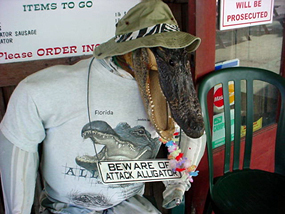
|
Colorful decorations and signs at Coopertown (Photos by Liza Hearon). |

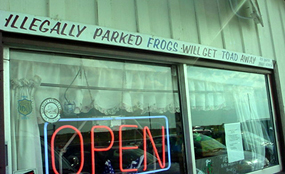
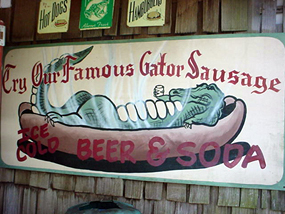
Comments are Closed